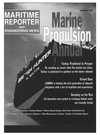
Page 75: of Maritime Reporter Magazine (September 1999)
Read this page in Pdf, Flash or Html5 edition of September 1999 Maritime Reporter Magazine
PB: Obviously, there is not a surpris- ingly different way in which the two groups do business. Under Vickers,
Kamewa and the other marine business- es focus very much on profitable growth and technology, where Ulstein was more active on commercial and service expansion. It relates a little to the strengths of both the Swedish and Nor- wegian culture. Bringing the two together makes, of course, a very pow- erful business culture.
So far, the 11 integration teams, com- posed of executives from all over the world, are mainly British, Swedish and
Norwegian, and are performing remark- ably efficiently and smoothly.
MR: What are the strengths of your product and service line?
PB: The strengths of our product line are obviously that we can claim to be leaders in propulsion, positioning and active stabilization and have the highest technology in ship systems and design.
Our new Mermaid POD propulsion sys- tem has had a remarkable and successful acceptance by the market who acknowl- edge these systems as the future in spe- cific sectors of the market.
MR: What does the future look like for Vickers?
PB: The future strategy for Vickers concentrates around opportunities for the three divisions. We see in Defense a movement for consolidation of compa- nies who are active in land systems in
Europe and expansion into a trend to look at lighter armed vehicles. As a dominant player in that sector of the industry, we will actively pursue oppor- tunities to stimulate a sound consolida- tion process in the interest of our share- holders. Turbine Components is an industry that is also going through a phase of consolidation. We invested adequately in our manufacturing infra- structure and will continue to do so in 1999 to finally develop the optimum 'state of the art' supply base that our customers in aerospace, industrial, gas turbine and the automotive industries are rightly expecting from us.
And the Vickers Ulstein Marine Sys- tems division, which now accounts for 50 percent of our turnover, will undoubtedly continue its strategy for sound and profitable expansion.
MR: What attracted you to the lead position with Vickers?
PB: I have always run or been involved with international engineering businesses. Vickers, of course, is one of the strongest corporate names in the world. It also has a very strong historic connotation, which, for a European such as myself, is very interesting.
Furthermore, it looked challenging for me to work with a strong management team to expand the business into a world leading engineering group again and to demonstrate to our shareholders that their faith, trust and investment is very well placed with Vickers.
The enthusiastic support from Sir
Colin Chandler, chairman, and the members of the Board was also an important element in the decision-mak- ing process.
I must say that, so far, we are very much enjoying this interesting phase in
MR: What are your guiding business philosophies?
PB: Being very pragmatic and trying with a 'passion for excellence' to bring across to my people that profitable growth is the main objective for the group. Profit is, indeed, of critical importance in order to continuously invest in the business, to return to our shareholders the financial share that would continue to attract the involve- ment of an expanding group of investors and last, but not least, to keep and attract outstanding partners in all our business- es.
I have a very strong belief in personal commitment, in a no-nonsense manage- ment style with direct communication with all parties involved, including our customers, who I particularly regard as our history. they are entitled to receive, and that our most important relationship.
Ne>w Simulator Training for
Pilots and Tlig Captains
Tractor Tug
Handling for Pilots
A three-day course in tractor- tug capabilities and utilization for Marine Pilots. The purpose of this course is to develop skills as they pertain to Z-drive and VS tractor tugs. It provides an opportunity to experience new ways of handling these highly maneuverable tugs.
Course begins with an introduc- tion to tractor-tug types, then proceeds through tug place- ment and the effect on the assisted vessel. Also includes tug capabilities and limitations by types: Voith-Schnieder propulsion, azmuthing bow- and stern-driven tugs and combi- tugs. Choice of ship size/type, harbor, piers, winds, tug/s.
Advanced Tug
Operations
A three-day course for Tug
Captains and Mates to help them develop advanced skills in transitioning from cable-towing to pushing mode and swinging on the hip - heads or tails. During simula- tion exercises, the tug and the barge (or ship) each react to forces independently (sliding, heeling, turning, etc.). Various type tugs (conventional, tractor, etc.) and barge- or ship-sizes are available. Simulator exercises can be conducted in your Port or Waterway.
To schedule these courses at any MSI Center, call Tom Garrigan at 718-565-4183 or submit your request via our website www.marinesafety.com. MarineSafety international *
New York, NY Newport, Rl Norfolk, VA San Diego, CA Rotterdam, Neth. (718) 565-4180 (800) 341-1353 (757) 423-2320 (619) 231-3333 +31 10 486 66 54
Circle 211 on Reader Service Card 77

 74
74

 76
76
